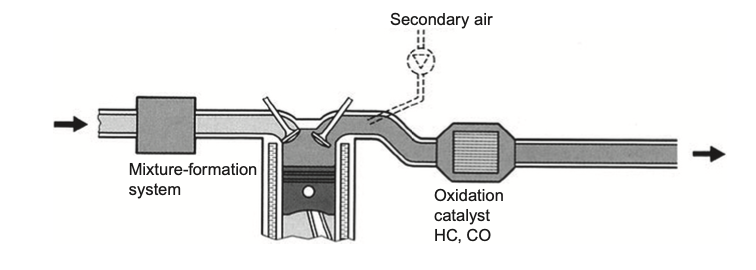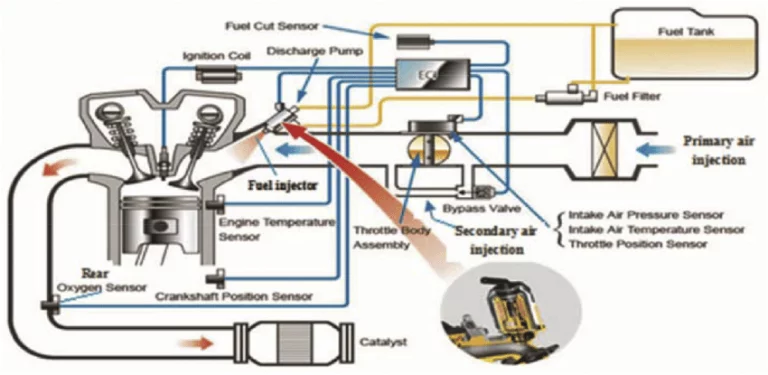The use of catalytic converters has become widespread in modern vehicles due to their ability to reduce harmful emissions, such as nitrogen oxides (NOx), carbon monoxide (CO), and hydrocarbons (HC). However, early catalytic systems often had limited efficiency and relied on the quality of fuel and the engine’s operating conditions. To overcome these limitations, engineers developed a new system known as the early catalytic system with additional air injection.
What is an early catalytic system with additional air injection?
An early catalytic system with additional air injection is a type of emission control system that was introduced in the 1970s. The system consists of a catalytic converter, an air injection pump, and a diverter valve. The air injection pump injects fresh air into the exhaust system to increase the oxygen levels in the exhaust gas, which helps to reduce emissions.
How does it work?
The early catalytic system with additional air injection works by introducing fresh air into the exhaust system before it reaches the catalytic converter. The additional air reacts with the unburned fuel and oxidizes it, producing heat. The heat helps to activate the catalyst in the converter, which then breaks down harmful pollutants into less harmful compounds.
The diverter valve in the system is used to control the flow of fresh air into the exhaust system. During normal engine operation, the diverter valve sends fresh air to the catalytic converter. However, during cold starts, the diverter valve redirects the fresh air to the exhaust manifold to help warm up the engine faster.
What are the benefits of an early catalytic system with additional air injection?
The early catalytic system with additional air injection has several benefits over earlier catalytic systems. Firstly, the system is more efficient at reducing emissions, as the additional air helps to burn off more pollutants. Secondly, the system is less reliant on the quality of fuel and engine operating conditions, making it more effective in a wider range of driving conditions. Thirdly, the system is relatively inexpensive and easy to install, making it a popular choice for early emissions control systems.
What are the drawbacks of an early catalytic system with additional air injection?
One of the main drawbacks of an early catalytic system with additional air injection is that it requires a separate air injection pump, which adds weight and complexity to the engine. Additionally, the system may reduce fuel economy due to the increased pumping losses from the air injection pump. Finally, the system may be less effective at reducing emissions during high-speed driving, where the additional air may be unable to keep up with the high flow rate of the exhaust gases.
Conclusion
The early catalytic system with additional air injection was a significant improvement over earlier catalytic systems, offering increased efficiency and reliability. While the system has some drawbacks, its low cost and effectiveness in a wide range of driving conditions made it a popular choice for early emissions control systems. Today, modern vehicles use more advanced emission control systems, but the early catalytic system with additional air injection remains an important milestone in the development of automotive emissions control.
As mentioned in the previous answer, the early catalytic system with additional air injection was introduced in the 1970s as a way to reduce harmful emissions from vehicles. This system was an improvement over earlier catalytic systems because it introduced additional air into the exhaust system, which helped to burn off more pollutants.
The system works by using an air injection pump to inject fresh air into the exhaust system before it reaches the catalytic converter. This additional air increases the oxygen levels in the exhaust gas, which helps to burn off unburned fuel and other pollutants. The heat generated by the burning fuel helps to activate the catalyst in the converter, which then breaks down the remaining pollutants into less harmful compounds.
The early catalytic system with additional air injection was a significant improvement over earlier catalytic systems because it was less reliant on the quality of fuel and engine operating conditions. Earlier catalytic systems were often only effective when the engine was running at certain temperatures and using high-quality fuel. The early catalytic system with additional air injection was able to reduce emissions in a wider range of driving conditions.

One of the drawbacks of the early catalytic system with additional air injection is that it required a separate air injection pump, which added weight and complexity to the engine. This pump was driven by a belt connected to the engine, and it added additional drag on the engine, which could reduce fuel economy. However, the benefits of reduced emissions were considered to outweigh the drawbacks of the additional weight and complexity.
Overall, the early catalytic system with additional air injection was an important milestone in the development of automotive emissions control. While modern vehicles use more advanced emissions control systems, the early catalytic system with additional air injection laid the foundation for the development of these more advanced systems.
Sure, here are some advantages and disadvantages of the early catalytic system with additional air injection:
Advantages:
- Reduced emissions: The early catalytic system with additional air injection significantly reduced harmful emissions from vehicles, including nitrogen oxides (NOx), carbon monoxide (CO), and hydrocarbons (HC). This helped to improve air quality and reduce the negative impact of vehicle emissions on the environment.
- Reliability: The system was more reliable than earlier catalytic systems, as it was less reliant on the quality of fuel and engine operating conditions. This meant that the system was effective in a wider range of driving conditions, making it more practical for use in different types of vehicles.
- Low cost: The early catalytic system with additional air injection was relatively inexpensive and easy to install. This made it a popular choice for early emissions control systems, as it provided a cost-effective solution to reducing emissions.
Disadvantages:
- Added weight and complexity: The system required a separate air injection pump, which added weight and complexity to the engine. This could reduce fuel economy and increase the risk of mechanical failure.
- Reduced performance: The additional air injection could reduce engine performance, as it required additional power from the engine to run the air injection pump. This could result in reduced acceleration and lower top speeds.
- Limited effectiveness: The early catalytic system with additional air injection may have been less effective at reducing emissions during high-speed driving, where the additional air may have been unable to keep up with the high flow rate of the exhaust gases.
Overall, the early catalytic system with additional air injection was an important step in the development of emissions control systems










